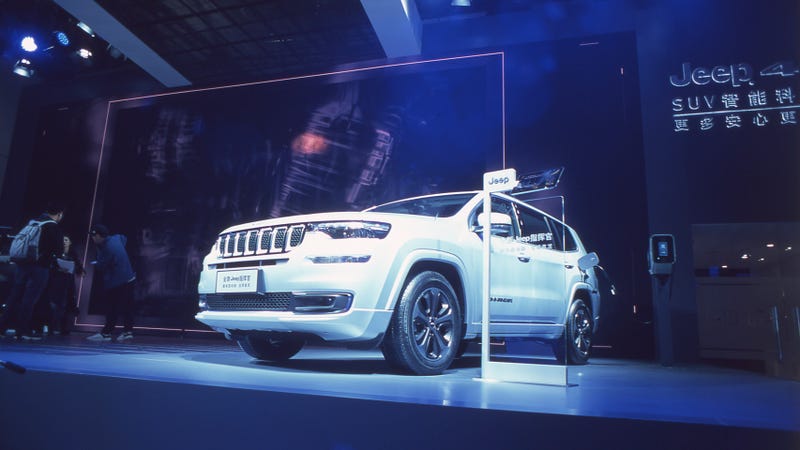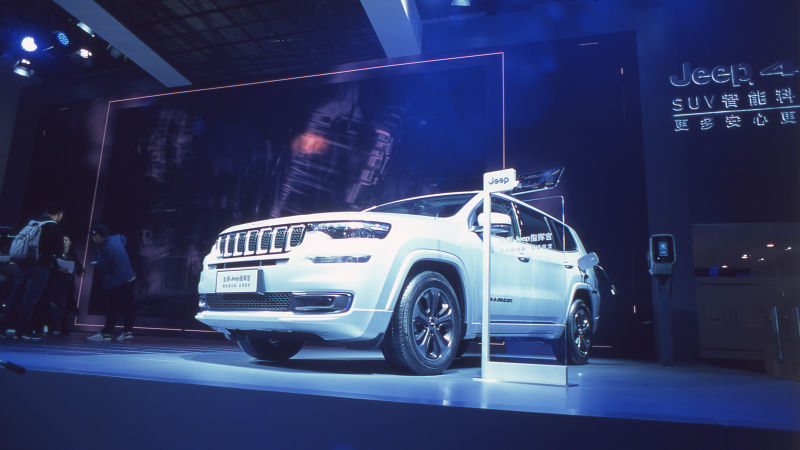
My plane had only touched down an hour or two earlier and I was quick to get out of my hotel—to find some breakfast, to see the city and to see all of the interesting Chinese cars that I’d only ever read about. And just as I rounded a corner, there they looked back at me, parked beside each other: a Cadillac and a Jeep.
[Full Disclosure: The reason why I was in China at all was because Geely flew me out to cover the Shanghai Auto Show and drive a few of its new cars. The company paid for my flights, hotel, and rather expensive visa application to get over there for a few days.]

What was funny was that though these were ostensibly American cars, they weren’t exactly like what you’d find in America. The Cadillac was a red ATS sedan. That’s a rare breed in the States, where we seem to lease an unending stream of BMWs. Moreover, that ATS wasn’t just a product of Cadillac as it is in the U.S., it was built in China by SAIC-GM, GM’s joint venture here.
The Jeep, too, was more Chinese than you’d think. Even though it looked just like, well, any modern American crossover, it’s actually a China-only model, a Grand Commander. This is another joint venture product, done with GAC down in Guangzhou, the company that keeps bringing its Trumpchi brand to the Detroit Auto Show.
Advertisement
Before I get too far along, let me first say that while I saw nothing but similarities between the cars on the road in China and the cars I see back in the States, every person I talked to who actually lived in China saw nothing but differences.
It was Ash Sutcliffe, a Brit expat who runs PR for Geely, who would turn to me and ask how it is that everyone in America drives such huge pickup trucks. The idea of anyone driving a Ford F-350 for anything other than overthrowing a government and rebuilding society from scratch seemed like a waste.
Advertisement
And it was my buddy’s wife, Mel, born and raised in China, whose dad is a cab driver in Beijing, who pointed out first that people in America buy big SUVs because they have larger families, or maybe just go outdoors more. I was asking about what was similar. She saw what was different.

I did wonder, though, if people were using cars differently in China than Americans do here. And indeed it was Ash who was quick to point out that Chinese drivers tend not to be as focused on long road trips as Americans.
Advertisement
“My biggest comparison between the U.S. and China is that they both have love affairs with vehicles and the profound levels of personal freedom they bring,” Ash wrote to me in a follow-up email. “The difference would be in the consumption patterns. Chinese consumers are driving trends like smaller displacements that are often backed by electrification as well as higher levels of connectivity.”
“On the other hand,” Ash went on, “Chinese rarely undertake long distance journeys as the bullet train system is more comfortable, convenient and cheap to use.”
Things get more interesting, though, when you look at raw numbers of who is buying what in China.
Advertisement

As of midway through last year, American car brands accounted for about one in ten new car sales, as Bloomberg reported from numbers published by the China Association of Automobile Manufacturers. That figure was publicized as being down a percentage or two from years prior, but that was mostly chalked up to Ford’s lineup of cars being pretty old by then. Indeed, Ford sales on their own had dropped by 36 percent and it was hard to spot a Ford in Shanghai. Other American cars, though, were still pretty common. It was a normal sight to see two China-only Buick GL8 minivans side by side in traffic, and even Jeep Wranglers weren’t hard to spot.
Jeep was the first foreign company to take up China’s policy (only recently fading away) to only allow foreign carmakers into China if they partnered with a local company in a forced joint-venture. It formed Beijing-Jeep, which was something of a disaster, and Jeep remains kind of a continuing problem. But that’s a complicated story for a different time.
Advertisement

Since it’s the first name on anyone’s lips, Buick sales in China are pretty good. I nearly wrote that GM claimed 225,313 sales over the past year, almost as many as the popular Wuling (262,214 units), whose microvan everyone drives outside the cities. I had those figures wrong; they were for just one financial quarter. Buick actually sold 1,020,496 vehicles in China last year, as a company representative noted in an email, the third year it has topped a million in sales over there.

Advertisement
But only about 36 percent of those sales are of Buicks that are sold in the American market. The Excelle, Excelle GT, Verano, GL6, and GL8 are all Chinese-market cars, along with other “NEVs,” or “New Energy Vehicles,” China’s catch-all for everything from natural gas-powered cars to pure EVs.
Keeping an eye out on the street makes this all seem pretty unsurprising as the lion’s share of these things on the road are of models we don’t get in the U.S., but it seems to me that the lion’s share is in Chinese models. I’d guess that shift is only going to climb, too, as Buick will be putting a full EV on sale later this month, the rather handsome Velite 6. Specs are what’s normal for EVs in China, with GM claiming 186 miles of range in the city, 113 horsepower, and pricing between $25,000 and $27,000 USD (165,800-185,800 RMB) after incentives.

Advertisement
Why is there such a demand for American cars in China that they’re not only getting built here, but that there are their own models? It didn’t take all too long to get a sense why.

It stands out the moment you get in a car: The roads are the same.
Roads here are almost indistinguishable from what you find in the States. Big open highways, jammed with traffic during commuting hours, wide and sweeping when not. Inside Shanghai in particular is virtually indistinguishable from LA, just with taller buildings. Elevated highways stack on top of each other like spaghetti in between the unending apartment blocks and assorted skyscrapers. American cars thrive in this environment, being comfortable, affordable, and at least when you’re in China, just a little bit interesting without coming across as strange. The look is spot on, with pretty conservative lines but plenty of spots for chrome. Even the domestic market Chinese cars, from BYDs to Geelys, share this kind of style.
Advertisement

The roads are the same and the driving style is the same: bored and distracted. Everybody’s on their phones. I’ve never been so comfortably reminded of being home as glancing into the car next to me to see the driver idly texting while a locally-built Volkswagen or Roewe merges in front of them.

Advertisement
The only thing that’s really different is America is full of giant pickup trucks, but in their place here in China are vans and minivans. Proportionally what you see in America represented by pickups seemed almost identically matched in China with vans, particularly once you got out of the city. Out in the farmland, where the quality of the roads almost instantly dropped off, it was like everything that wasn’t a somewhat beat up Wuling or Jinbei disappeared.

The Wuling, if you’re curious, is the small minivan of choice, a product of a GM joint venture and something of a new skin wrapped on what’s basically a Japanese micro van from the ‘80s, though it has been changed and tweaked so many times over the years it’s hard to say what connection it has to anything else at this point. The Jinbei is simpler, pretty much just a copy of a Toyota HiAce.
Advertisement

But this pickup/van switch is understandable when you realize that gas is unbelievably cheap in America by contrast. The Chinese government gave up subsidizing gas prices years ago, as Ash laughed to me. The early cars he remembered when he first moved here, cheap, big engine cars, have mostly disappeared along with ultra-cheap gas. (Subsidies on gas are hard to track down in english-language media, but China did formally commit to reducing subsidies in a global summit in 2016.) This is all to say that the use of smaller vans rather than pickups makes sense if you need something practical and fuel-efficient.
Oh, there is one other sort of difference. Though you do see tons of straight-up American brands here on the roads, Cadillac CT6s and DTSs being the most surprisingly common in the city itself, what you see most of is American-style cars.
Advertisement

Of course American eyes are going to pick out every Buick on the road, but it’s easy stopping gloss over that even the Chinese cars here are super American style. Fleets of local SAIC-VW sedans tool around here, along with all of the Roewes and BYDs and everything else.

Advertisement
The difference is that tons of them are EVs and PHEVs. Spotting them isn’t hard, just look for the ones with green license plates not blue. (One of the biggest subsidies for these “new energy” vehicles in China is that you get your license plate for free and immediately. A license plate for a regular-powered car here in Shanghai will cost you something around $16 grand, as Ash was keen to point out. (Geely was, admittedly, happy to talk about EVs. The company just launched a new all-EV brand.) Other cities charge the same and also force you to get one through a lottery. That can take months or years. Congestion is no joke over here.

But again, the prominence of EVs around here makes sense given how much the government subsidizes them. It’s not like tastes in what these cars are is any different. You see plenty of Teslas on the roads (soon to be domestically produced here as well) and I’ve never seen so many Chevy Volts outside of LA. The ones here just happen to be badged as Buick Velites.
Advertisement

In any case, it was refreshing to finally get over to China and see at least a small bit of it. It’s not so much that it resolved some kind of puzzle so much as it cleared it up entirely. It always felt like some kind of mystery why the Chinese car market so closely mirrored America’s, but having seen the roads here, I’d be more surprised if it was any different.













